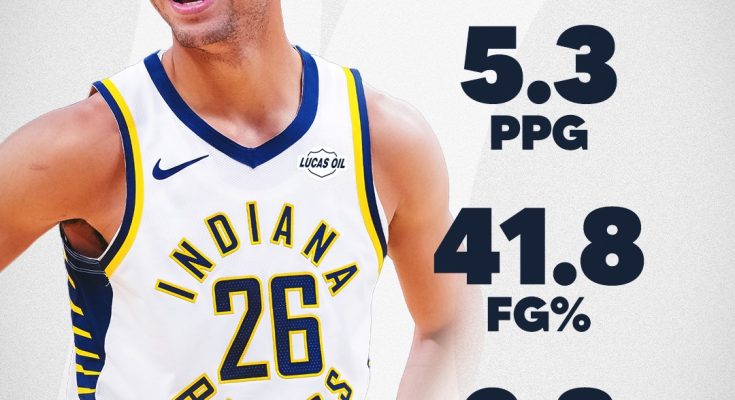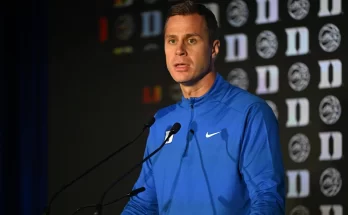Ben Sheppard’s growth during the 2024-25 NBA season has been nothing short of impressive. For the Indiana Pacers, a team that has been building a reputation as one of the deepest and most balanced rosters in the league, his development has been a critical piece of the puzzle. After coming into the league as a player many viewed as a high-energy role guy with shooting upside, Sheppard has proven he can do more than just fill space on the floor. This season, he boosted his minutes, scoring, rebounding, and assists averages, while also improving his field goal and three-point percentages, showing that he is not only finding consistency in his game but also adding more value to a Pacers team that continues to trend upward in the Eastern Conference.
From the beginning of his sophomore campaign, Sheppard looked like a player who had learned from his rookie year and was ready to take the next step. In year one, there were flashes of his potential—moments where his quick release from three or his willingness to defend on the perimeter stood out. But consistency was the hurdle, as it often is for young players adjusting to the speed and physicality of the NBA. The 2024-25 season, however, has been a much different story. Sheppard came into training camp with more confidence, better conditioning, and an improved understanding of his role within Rick Carlisle’s system. He wasn’t trying to do too much, but he was making sure that every minute he played counted. That translated into a noticeable boost in his playing time, as Carlisle showed more trust in him by giving him longer stretches on the court.
With the increase in minutes came the opportunity to contribute more, and Sheppard made sure not to waste it. His scoring averages rose, not because he was forcing shots, but because he was more selective, patient, and confident in his offensive abilities. His field goal percentage took a noticeable jump, and even more importantly for the Pacers’ system, his three-point shooting became more reliable. Indiana’s offense thrives on spacing the floor for Tyrese Haliburton to operate, and having shooters who can punish defenses for collapsing is essential. Sheppard’s ability to knock down threes at a higher clip gave Carlisle another weapon, which in turn made the Pacers’ offense even more dangerous.
But Sheppard’s improvement went beyond shooting. His rebounding numbers also climbed, showing his commitment to impacting the game in ways outside of scoring. For a wing player, rebounding often comes down to effort and positioning, and Sheppard displayed both. He was more aggressive in crashing the glass, helping the Pacers secure possessions and occasionally starting transition opportunities. This aspect of his game often goes overlooked, but on a team that plays with pace and looks to get out and run, having wings who can rebound effectively is a huge advantage.
Assists were another area where Sheppard took a step forward. While not expected to be a primary playmaker, his ability to move the ball and create opportunities for teammates grew noticeably during the season. Instead of being a catch-and-shoot player who either fired away or swung the ball quickly, Sheppard began showing more patience with his decision-making. He read defenses better, attacked closeouts with more purpose, and found open teammates in spots where they could thrive. These weren’t flashy assists, but they were the kind of smart, steady plays that coaches love because they keep the offense flowing and reduce wasted possessions.
One of the most encouraging signs of Sheppard’s growth was his efficiency. It’s one thing to score more points with more minutes, but to do so while increasing shooting percentages is a reflection of true progress. It shows a player learning which shots are within their comfort zone, improving mechanics, and making better decisions. Sheppard’s growth in this area suggests he wasn’t just riding the wave of opportunity but was actively improving as a shooter and scorer. In today’s NBA, where spacing and efficiency are crucial, a player who can knock down shots at a high clip while not being a liability on the other end becomes extremely valuable.
Defensively, Sheppard remained committed to being active and disruptive. While his offensive improvements drew headlines, Carlisle and the Pacers coaching staff also relied on his energy and effort on the defensive end. He was often tasked with guarding opposing wings, fighting through screens, and contesting shots on the perimeter. While not yet an elite defender, his growth on offense didn’t come at the cost of his defensive effort, which is often the concern when young players start to find more scoring success. Instead, Sheppard seemed to embrace the challenge of being a two-way contributor.
What makes Sheppard’s progression so intriguing for the Pacers is how seamlessly it fits into their larger goals as a franchise. Indiana has built a team around Haliburton that is fast, versatile, and deep, and players like Sheppard add to that versatility. With Pascal Siakam and Myles Turner anchoring the frontcourt and Haliburton setting the tone as the playmaking engine, the Pacers need wings who can stretch the floor, defend, and make smart plays. Sheppard checks all of those boxes and is trending upward at the perfect time for Indiana’s aspirations.
The Pacers have been knocking on the door of contention in the Eastern Conference, and while stars like Haliburton and Siakam are the headliners, it’s the growth of role players like Sheppard that can push them over the top. Championship teams are often defined by their stars, but they are solidified by the contributions of players further down the roster who elevate their games. Sheppard’s leap in his second year has made him one of those valuable pieces, the kind of player who can change the momentum of a game with a hot shooting stretch or a key defensive stop.
There’s also the mental aspect of Sheppard’s growth that shouldn’t be overlooked. Confidence is everything in the NBA, and for young players, it can be the difference between sticking in the league and fading away. The way Sheppard has carried himself this season—with composure, belief in his abilities, and an understanding of his role—shows maturity beyond his years. He doesn’t look rattled when the game speeds up, and he doesn’t try to force his way into the spotlight. Instead, he plays within himself, contributing in multiple ways and trusting that his consistency will be noticed. That kind of mentality bodes well for a long career.
Looking ahead, the question becomes just how high Sheppard’s ceiling can be. While it’s still early, his trajectory suggests he can become more than just a solid rotation player. If he continues to develop his shot creation, ball-handling, and defensive versatility, he could carve out a role as a reliable starter for years to come. The Pacers, known for developing and maximizing the potential of their players, are in an ideal position to help him get there. Carlisle’s system rewards smart, hard-working players, and Sheppard has shown he fits that mold perfectly.
What’s particularly exciting for Indiana fans is that Sheppard is growing at a time when the Pacers are assembling a core that could contend for years. His chemistry with Haliburton, his spacing alongside Siakam, and his energy on both ends make him an invaluable part of the team’s long-term outlook. In many ways, Sheppard embodies the identity the Pacers are trying to build—unselfish, hard-working, and efficient.
As the 2024-25 season continues, Sheppard’s numbers and impact will only draw more attention. The national spotlight tends to focus on the All-Stars, but savvy observers know that the leap of a young role player can sometimes be just as important. For Indiana, Sheppard’s development means they don’t just have a top-heavy roster but a well-rounded one that can weather injuries, match up with different opponents, and compete deep into the playoffs.
In summary, Ben Sheppard’s second season has been defined by growth in nearly every measurable category—minutes, scoring, rebounding, assists, field goal percentage, and three-point shooting. But beyond the numbers, it has been about confidence, maturity, and fitting into the Pacers’ bigger picture. He has gone from a promising rookie to a reliable contributor, and if his trajectory continues, he could become one of the key pieces in Indiana’s push toward true contention. The Pacers needed someone like Sheppard to step up, and he has answered the call, making his 2024-25 season not just a personal success story but also a significant boost to the franchise’s future.



